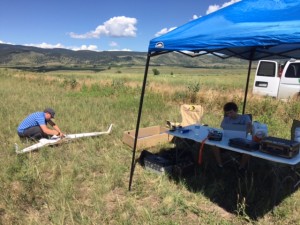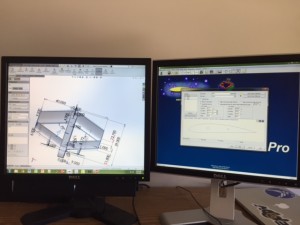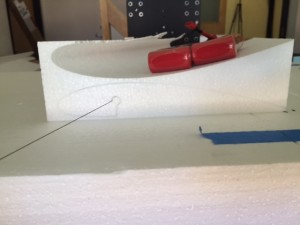As my internship enters its final week, we are getting busier as RECUV prepares for its next string of deployments. Over the past week, we conducted several flight tests of our new ground station in conjunction with a Skywalker UAV. Due to a few power problems within the ground station box, we were not able to hold a link with the aircraft for much more than a minute, but we have resolved these issues since the flight.
I’m starting to play a larger role within the flight crew, running the control station from a computer and giving commands and waypoints to the aircraft. This basically consists of creating the waypoints, sending them, and then telling the aircraft to fly them. It’s not the most traditional or exciting piloting method since the plane uses an autopilot and just follows my commands, but technically I can say I’ve flown a UAV, which I’m pretty proud of.
On Monday, we plan to fly again with the repaired ground station box, as well as test the van-following algorithm that was developed over the past few weeks. If all of these tests go well, we should be in very good shape for the deployments.
While a few people were working in the Fabrication Lab on the aircraft between tests, James and I spent most of last week (with the exception of the test flights) in the Indoor Vehicles Lab designing and beginning to build an aerodynamic prototype of RECUV’s newest UAV, which we have dubbed the Buffalo in honor of CU’s mascot.
We started with a Computer Aided Design (CAD) program called SolidWorks, which James used to model the design of the final aircraft. Using this model, we modified it slightly to make a glider prototype of the final aircraft so that we could test the airframe to make sure it is a viable design. If the prototype works as needed, RECUV will produce a twin engine version of the aircraft that will replace the Skywalker in RECUV’s fleet.
I helped design the prototype based off of James’ model of the final aircraft. Using a few other programs, I converted parts of the model into G-code—a programming language used in manufacturing which, in this case, is used to drive a CNC foam cutter. Once the G-code was created, we were able to use the foam cutter to make the wings and parts of the fuselage. By the end of the week, most of the foam parts had been cut and we will begin assembly after our flight tests next week.Hopefully the glider will be ready to fly before i leave so that I can see what I built fly, which would be really cool.
Whatever happens, my last week should be pretty busy and I’m looking forward to every bit!




There are no comments published yet.